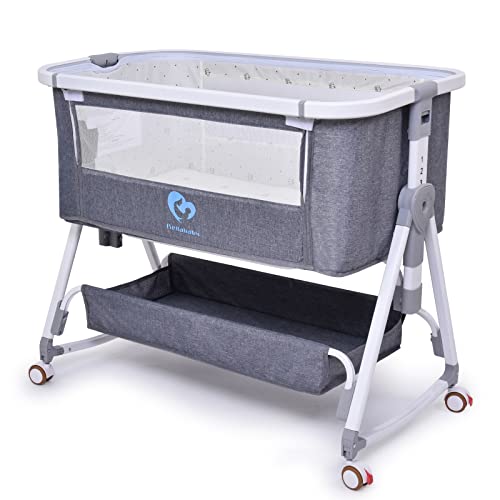A Productive Rant About Side Sleeping Crib

The Side Sleeping Crib: A Comprehensive Guide for New Parents
Welcoming a newborn into the world is a valued experience filled with joy and obstacles. Among the many factors to consider new parents must browse, choosing the best sleeping plan for their baby is paramount. One innovative solution that has gained appeal in the last few years is the side sleeping crib. This short article will explore the features, advantages, and considerations surrounding side sleeping cribs, supplying an indispensable resource for new parents.
What is a Side Sleeping Crib?
A side sleeping crib, also called a co-sleeper or bedside crib, is designed to supply a safe sleeping space for infants while preserving close proximity to their parents. These cribs can be connected to the side of an adult bed or utilized as standalone units. They use the convenience of co-sleeping without sharing the very same sleep surface, decreasing the danger of suffocation and helping with simpler nighttime feedings and soothing.
Advantages of a Side Sleeping Crib
- Increased Safety
Among the primary advantages of side sleeping cribs is boosted security. The American Academy of Pediatrics suggests that infants oversleep the exact same room as their parents for at least the first six months to decrease the threat of Sudden Infant Death Syndrome (SIDS). By utilizing a side sleeping crib, parents can keep their baby within arm's reach while adhering to security guidelines. - Convenient Nighttime Feeding
Nighttime feedings can be a difficult regimen for new parents, but a side sleeping crib makes this procedure considerably easier. Parents can just reach over to comfort or breastfeed their baby without needing to completely awake or get out of bed. - Eases the Transition to Independence
Side sleeping cribs can help in slowly transitioning babies into independent sleep environments. Parents can move the crib even more far from their bed with time, cultivating self-reliance while still keeping a complacency for the child. - Conserves Space
For families living in smaller homes or houses, a side sleeping crib occupies less space than a traditional crib, making it an ideal option for those with minimal room. - Promotes Bonding
Close distance enables parents to quickly keep track of and react to their baby's needs, fostering bonding and attachment throughout those essential early months.
Selecting the Right Side Sleeping Crib
When choosing a side sleeping crib, a number of elements need to be thought about to ensure it fits the needs of both the baby and the parents:
- Safety Standards: Ensure that the crib meets security requirements set by trusted organizations, such as the Consumer Product Safety Commission (CPSC).
- Adjustability: Look for cribs with adjustable heights to line up with the parents' bed and guarantee easy access.
- Stability: A silver lining sleeping crib needs to be stable without wobbling or sliding when attached to the parent's bed.
- Mobility: Consider cribs that are lightweight and have wheels for easy movement around your home.
- Material: Opt for cribs made from non-toxic materials that are free from hazardous chemicals.
Elements to Consider
While side sleeping cribs present numerous advantages, parents must also keep these factors in mind to make a notified choice:
- Size of the Bed: Ensure the crib fits firmly alongside the adult bed, without gaps that might present a security threat.
- Baby's Growth: Be mindful that as infants grow, their sleeping needs will change. Some cribs are convertible and can be used longer than standard cribs.
- Sleeping Habits: Consider how easily you and your partner get used to having the baby close by throughout the night.
Frequently Asked Questions About Side Sleeping Cribs
Q1: Are side sleeping cribs safe for newborns?A1: Yes, side
sleeping cribs offer a safe sleeping environment for newborns when utilized correctly, as they decrease the threat of SIDS while enabling parents to stay close.
Q2: How do I assemble a side sleeping crib?A2: Assembly guidelines typically accompany the crib. Guarantee it is firmly connected to the adult bed, following the guidelines supplied by the manufacturer. Q3: Can I use a side sleeping crib
for longer than six months?A3: Yes, lots of side sleeping cribs can accommodate infants beyond
6 months, depending on their development and development. Check the manufacturer's requirements for weight and height limitations. Q4: What if my baby rolls over?A4: Most side sleeping cribs are designed with safety features
to prevent babies from rolling out.
However, always monitor your baby and seek advice from pediatric guidelines about the ideal time to transition them to a crib. The side sleeping crib is a versatile and helpful sleeping option for new parents.
It provides safety, convenience, and support during the early stages of parenthood while promoting nearness in between parent and child. By thinking about Info , adjustability, and individual family needs, parents can make an informed decision about this essential piece of baby equipment. Table: Pros and Cons of Side Sleeping Cribs Pros Cons Boosted safety during sleep Minimal use duration as baby grows
Relieve of nighttime feeding May require additional space Promotes bondingAdjustmentperiod forparents and baby Conserves physical space Prospective for unforeseeable sleeping patterns Aswith any parenting choice, whatworks best will constantly depend upon private household characteristics. Stressing safety,comfort, and connection will assist parents selectthe right sleeping arrangements for their little ones to ensure an excellent start to
life.

